Abstract
The in vivo anti-influenza virus and antivaccinia virus activity of 156 biologically active compounds was determined. One of two criteria was used for evaluating activity against the influenza virus. The criteria were increase in survivor number and mean survival time, and reduction in virus-induced lung consolidation in treated, infected Swiss mice. Increase in survivor number and mean survival time were the criteria for evaluation of antivaccinia virus activity. Several drug doses were tested against two virus concentrations to demonstrate antiviral activity more clearly. Two compounds were considered significantly active against the influenza virus: DL-noformicin (NSC 72942) and amantadine hydrochloride (NSC 83653). Eleven compounds had reproducible activity against vaccinia virus: isatin-β-thiosemicarbazone (NSC 721), 6-azauracil (NSC 3425), 9-α-fluoro-2α-methylhydrocortisone 21-acetate (NSC 12601), 5-[bis(2-chloroethyl)amino]uracil (NSC 34462), 5-iodo-2′-deoxyuridine (NSC 39661), streptonigrin (NSC 45383), N-methylisatin β-thiosemicarbazone (NSC 69811), cytovirin (NSC 91770), 9-β-D-arabinofuranosyladenine (NSC 404241), and 5-(mercaptomethyl)uracil (NSC 529351).
Full text
PDF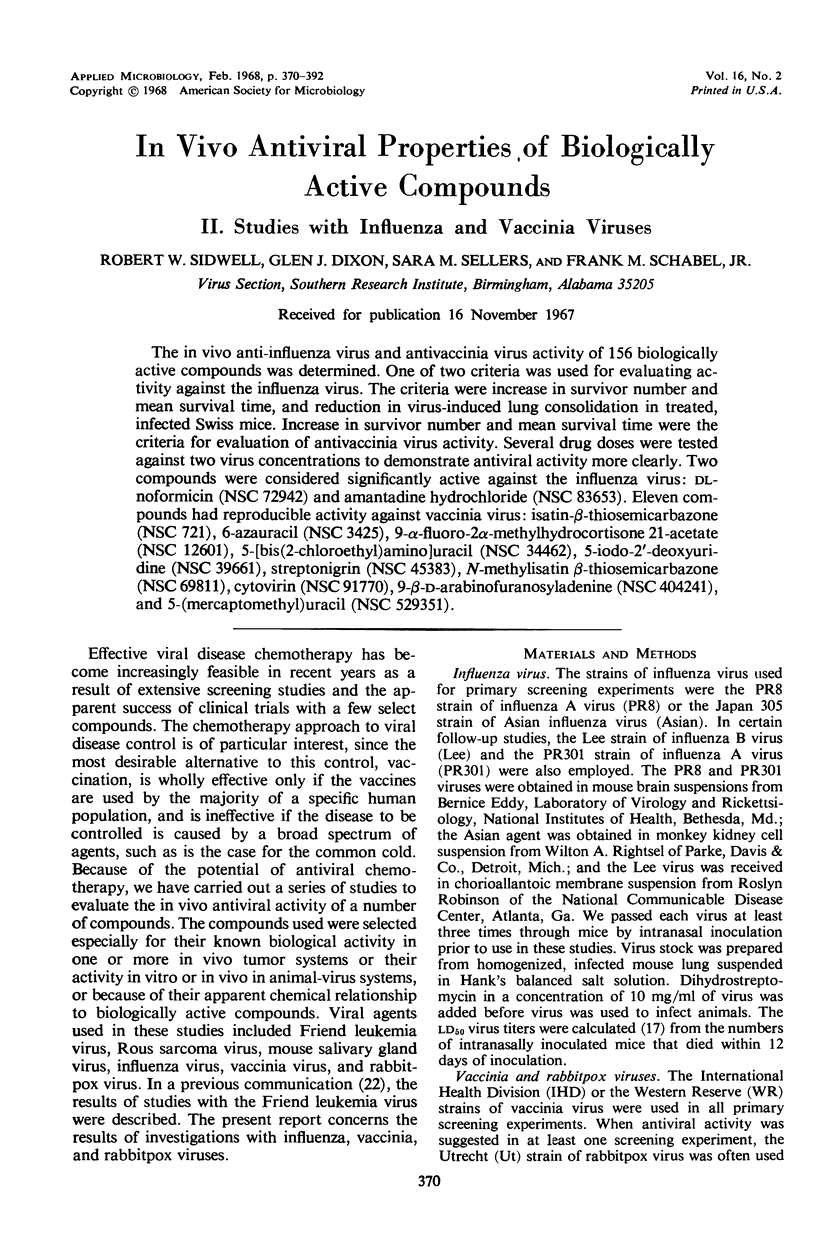
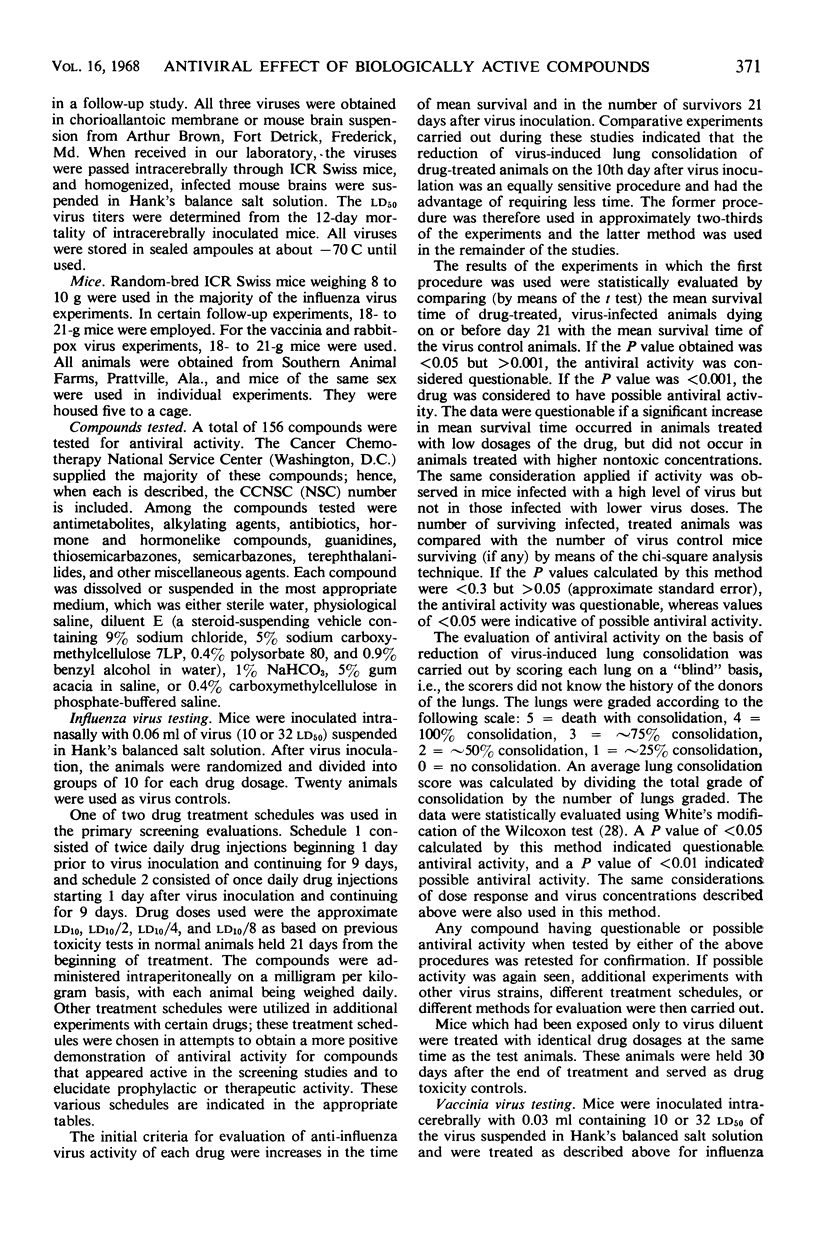
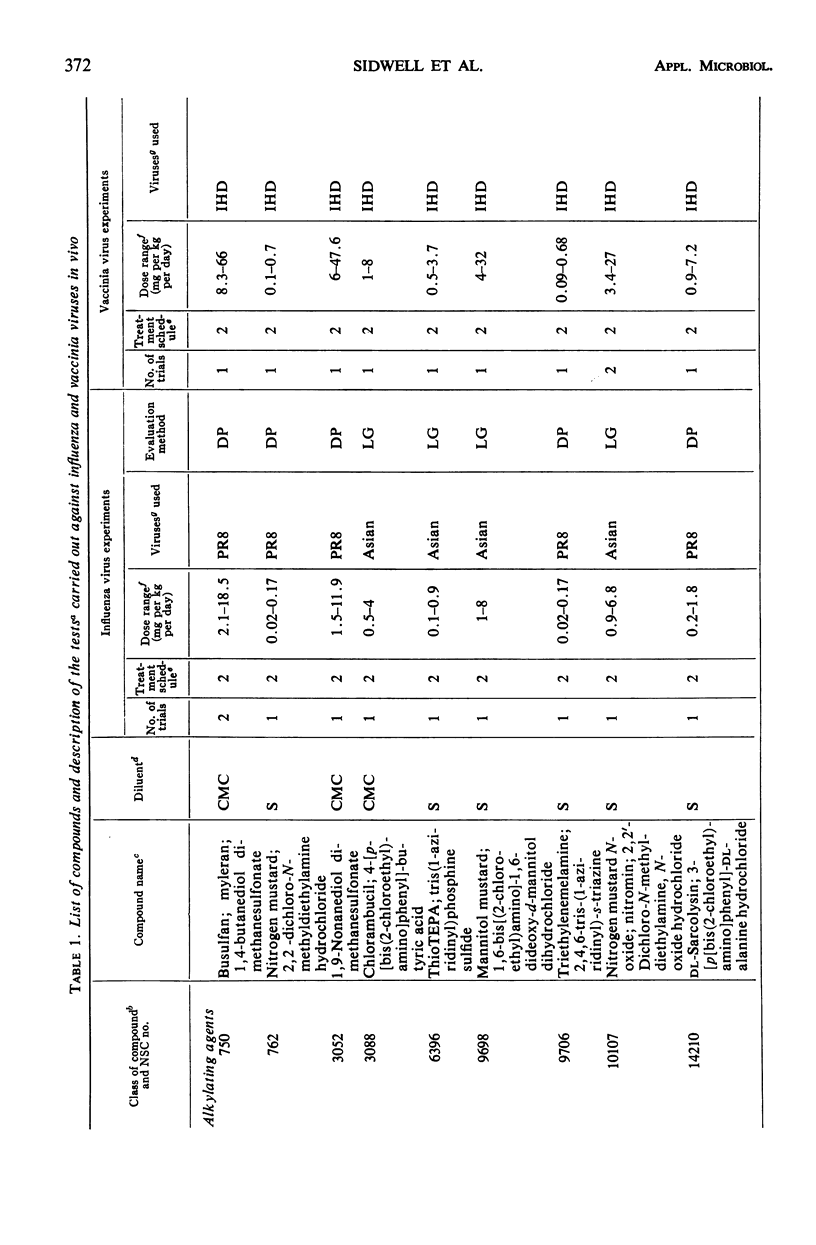
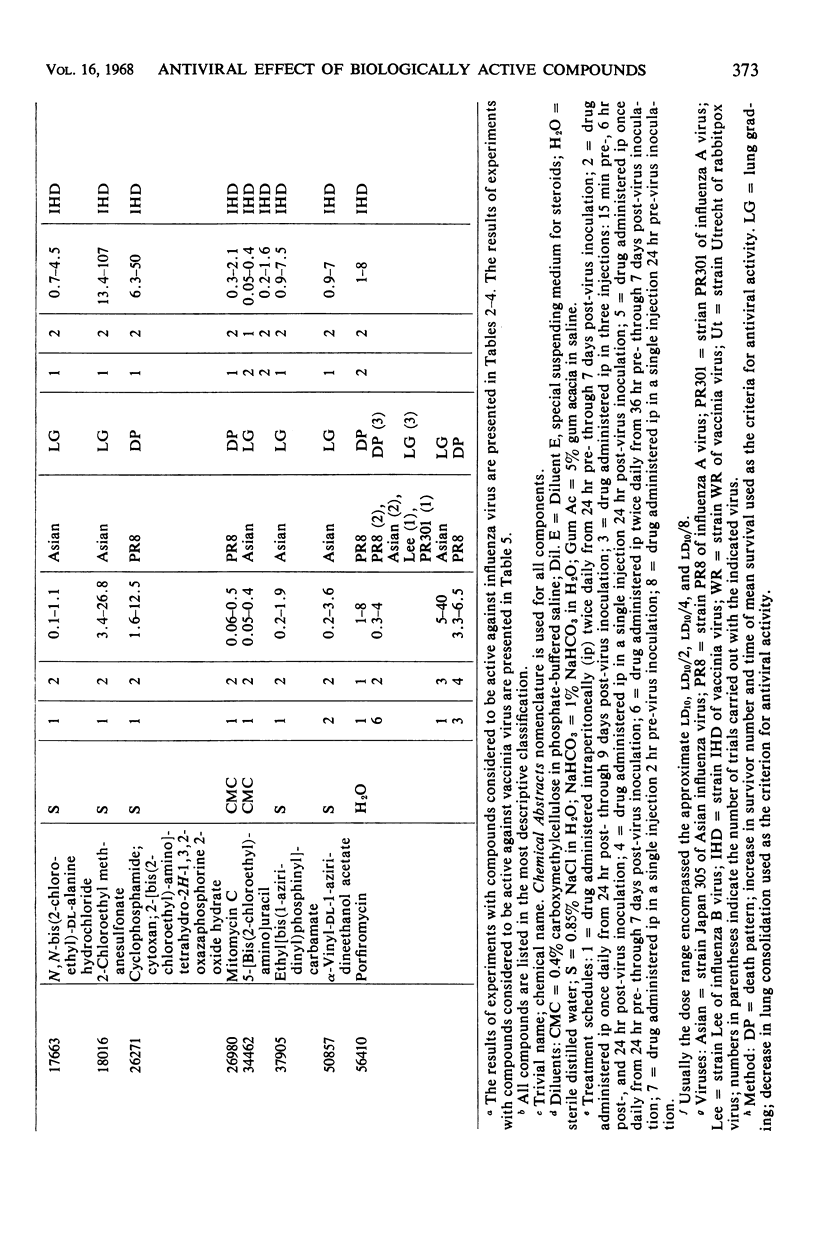
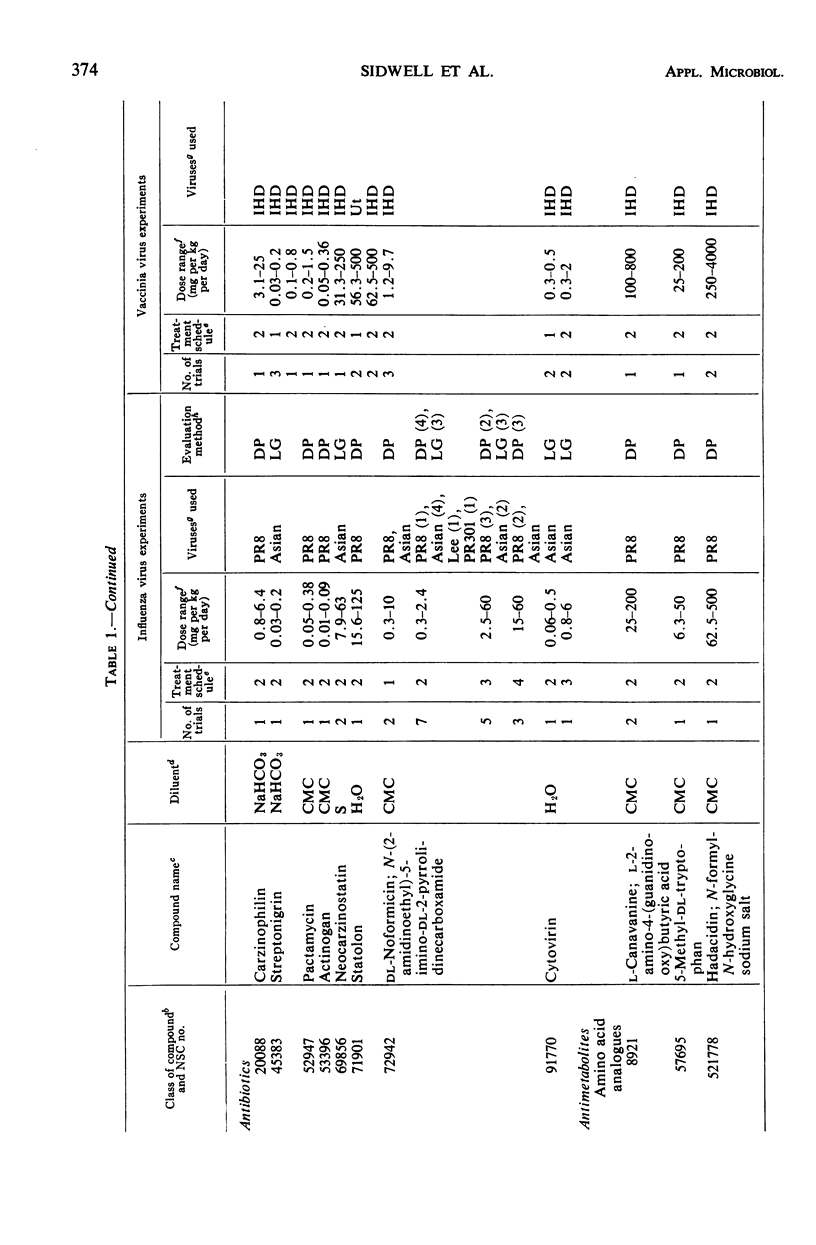
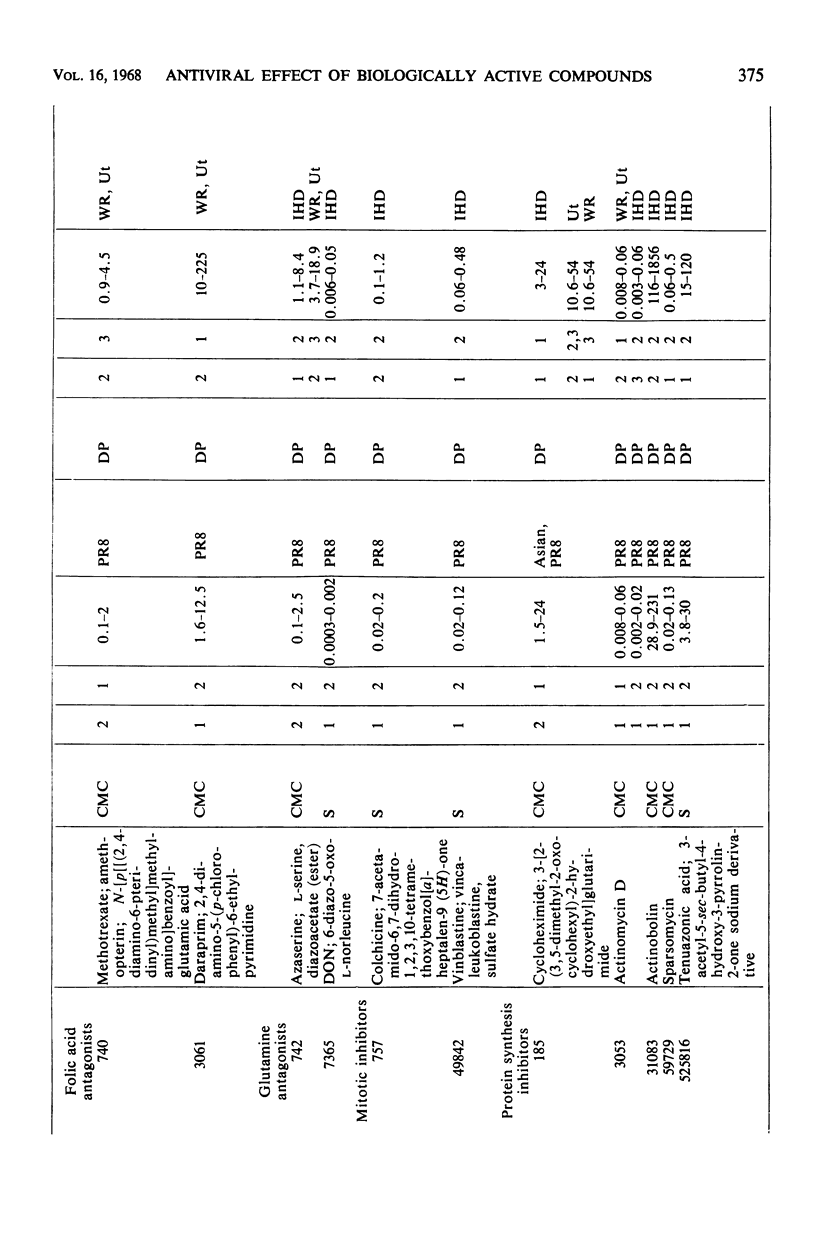
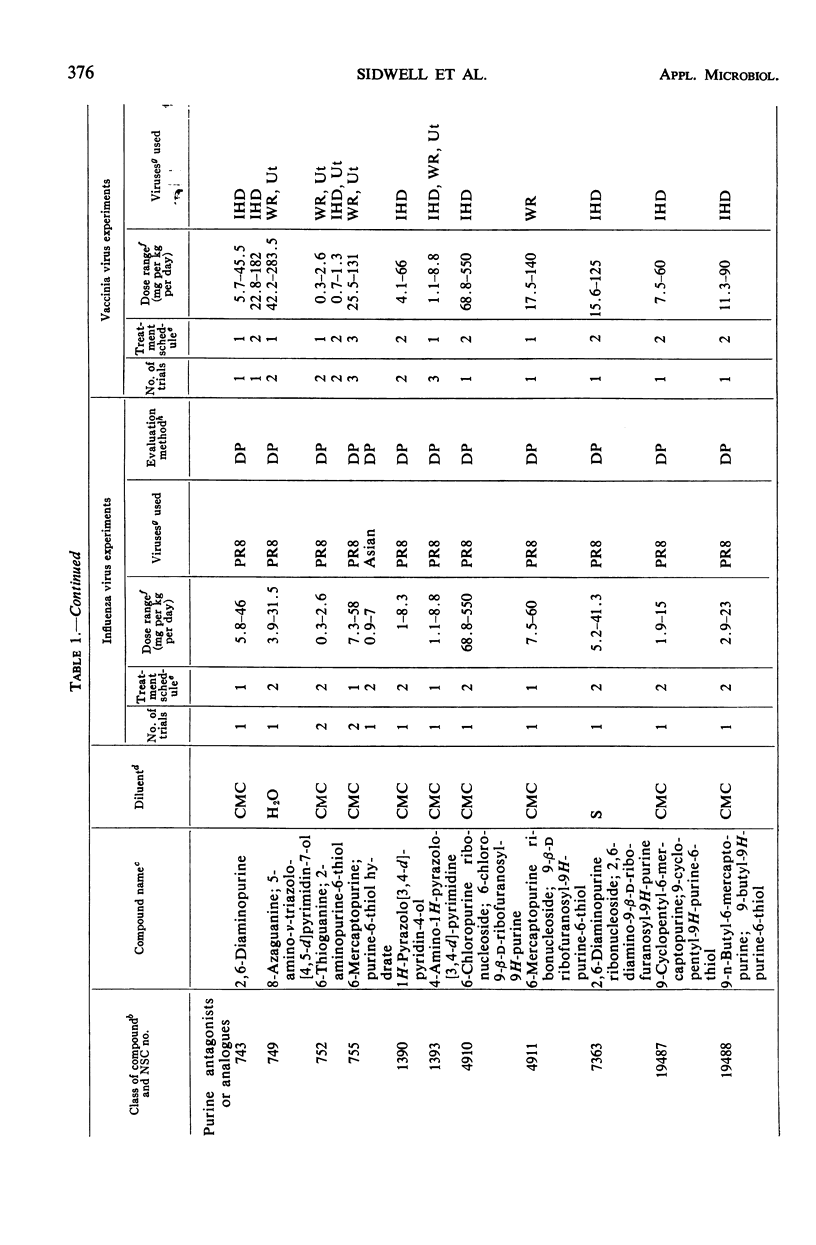
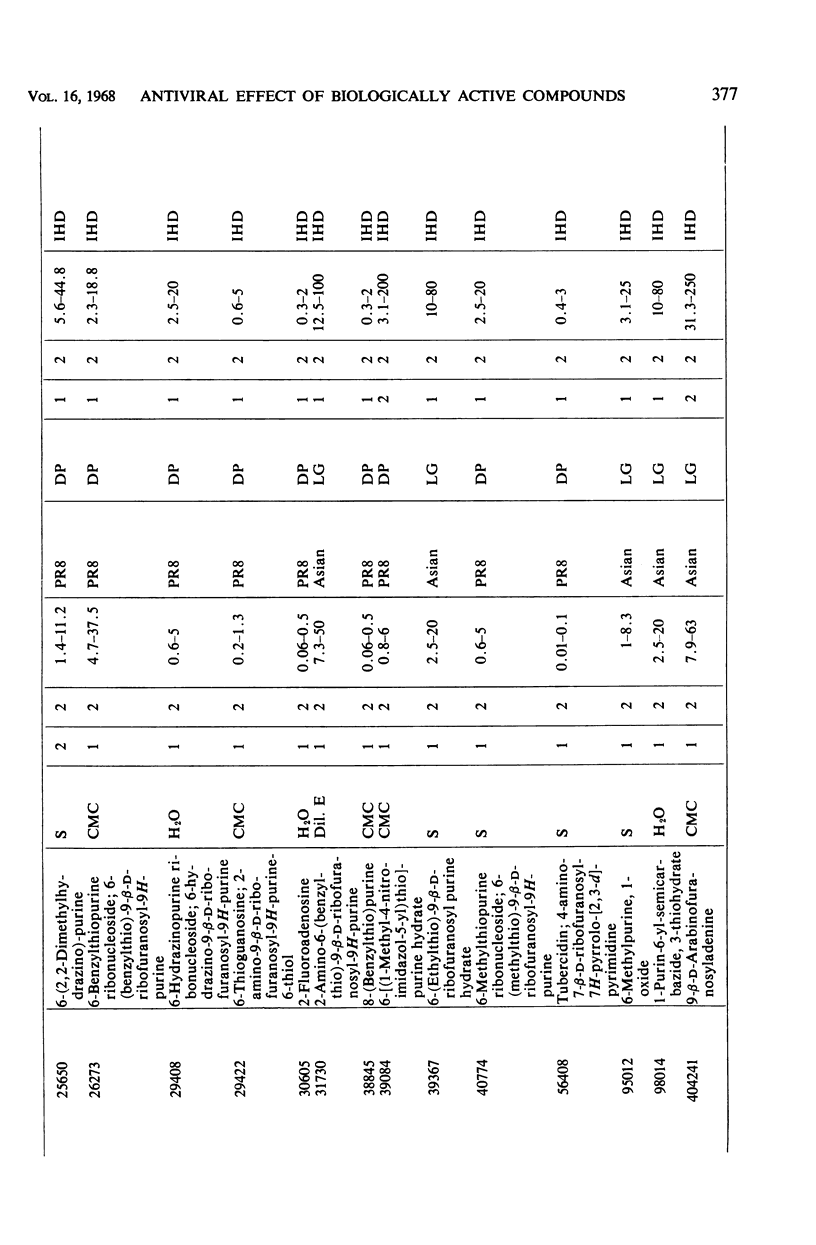
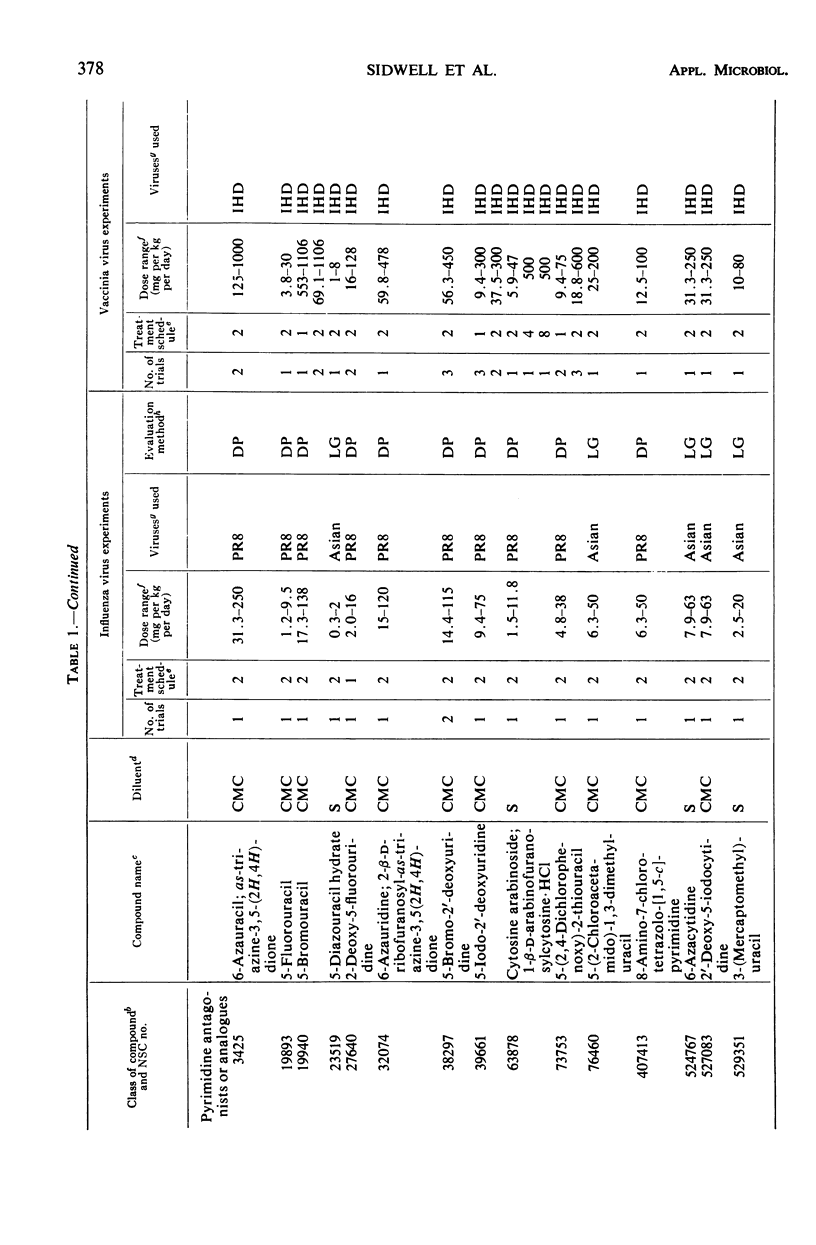
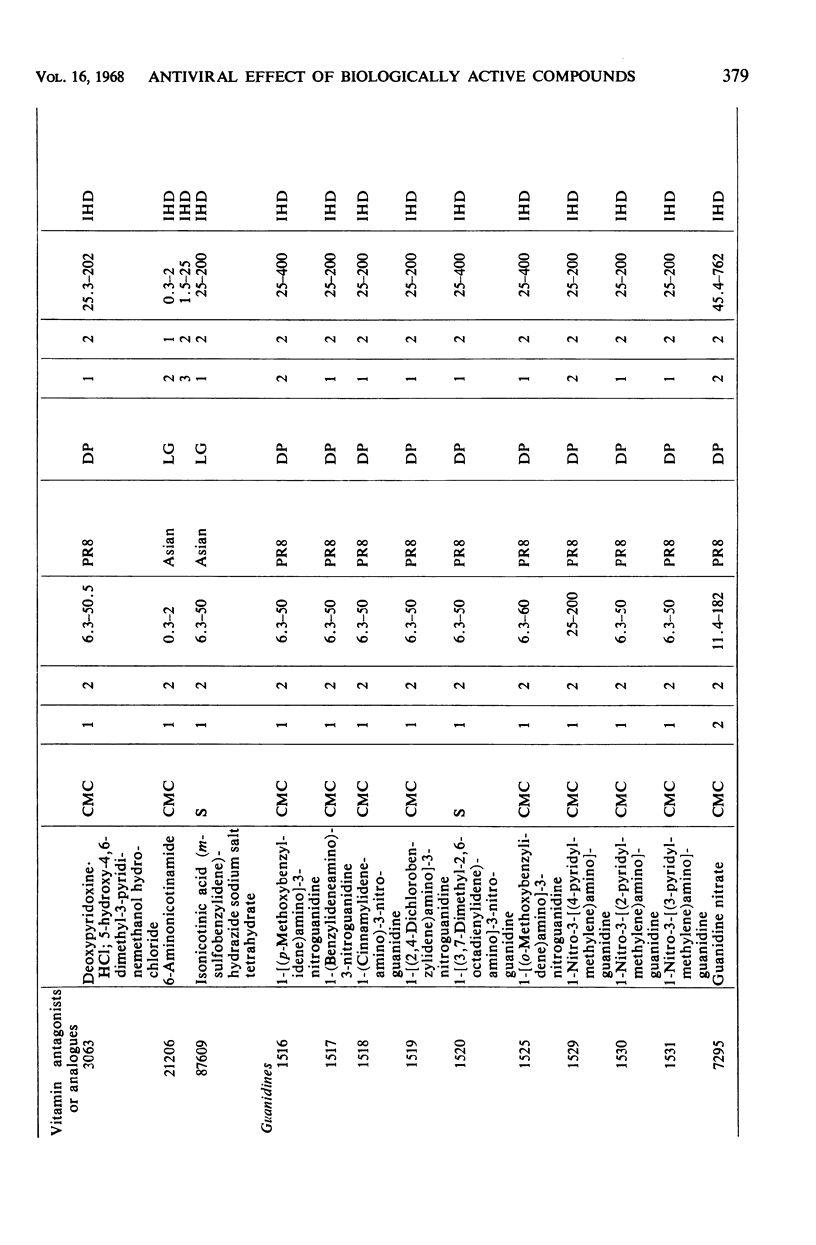
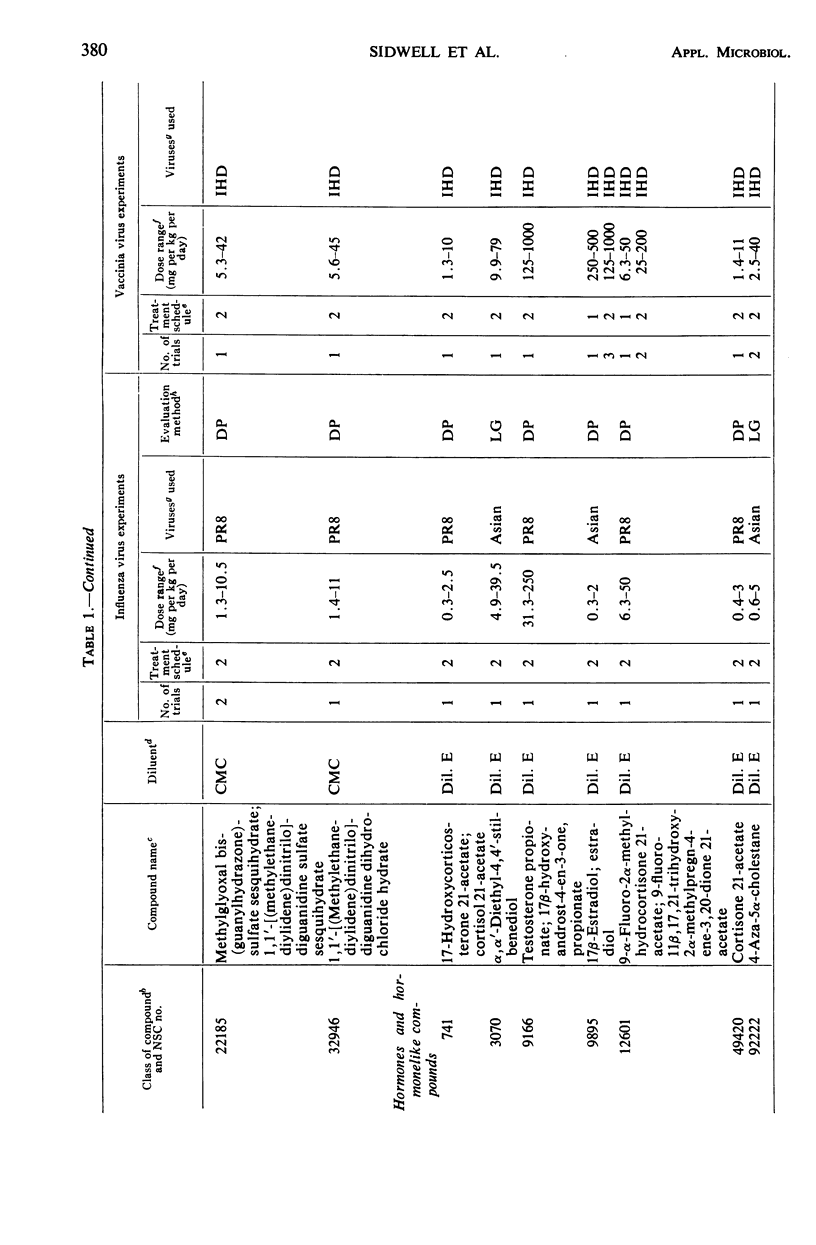
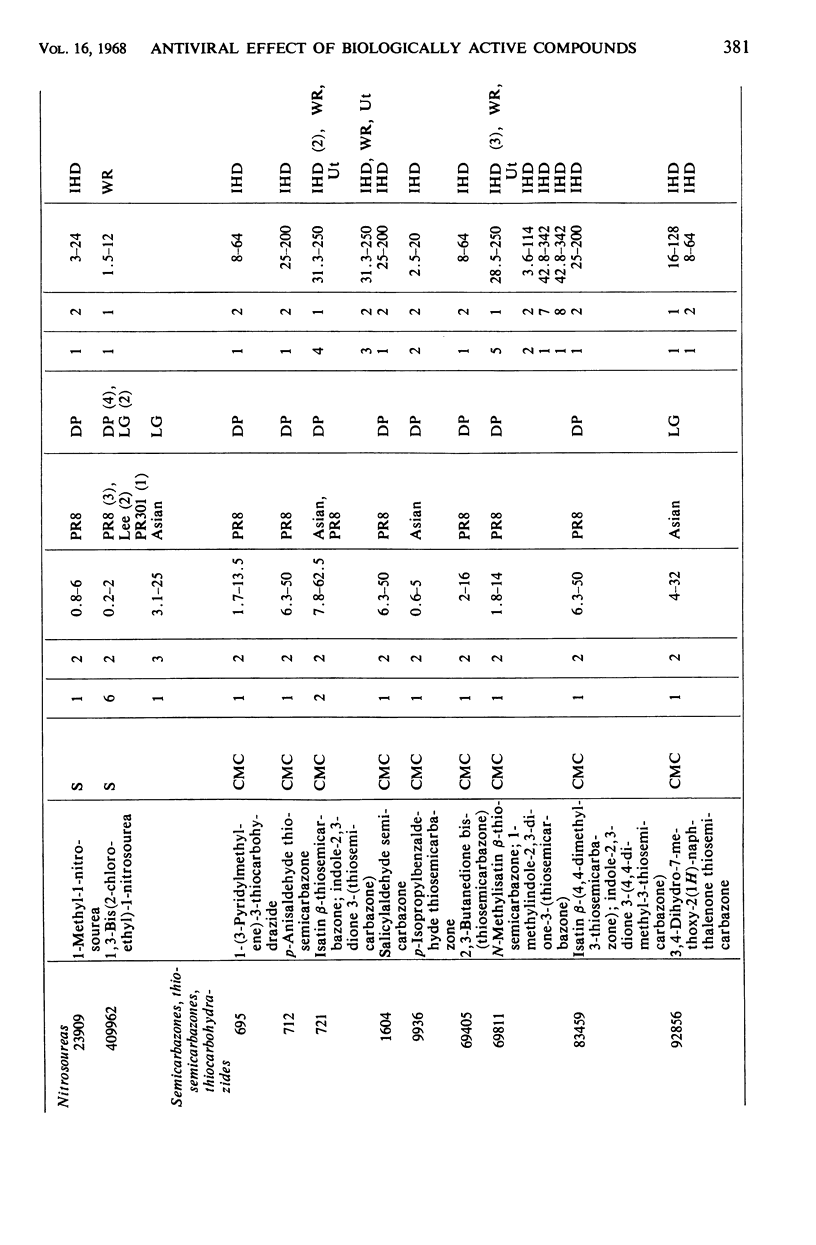
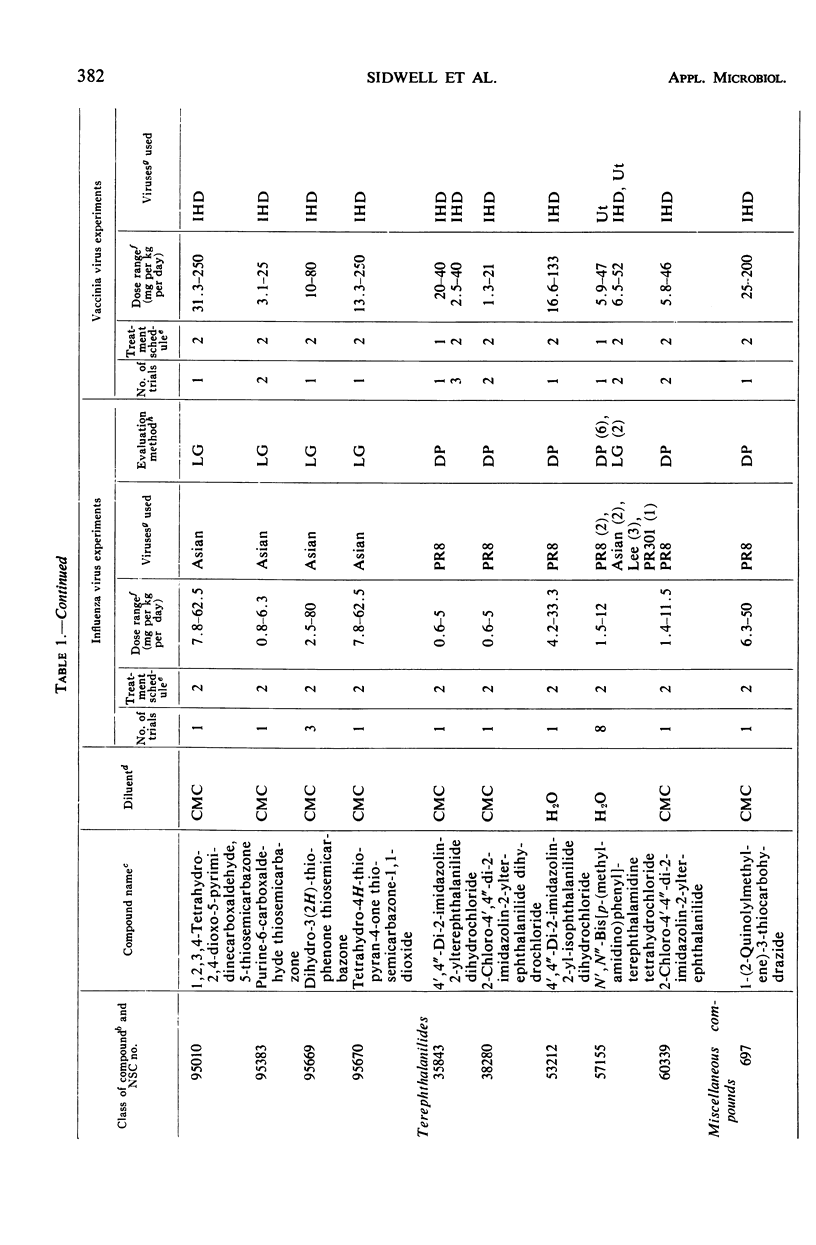
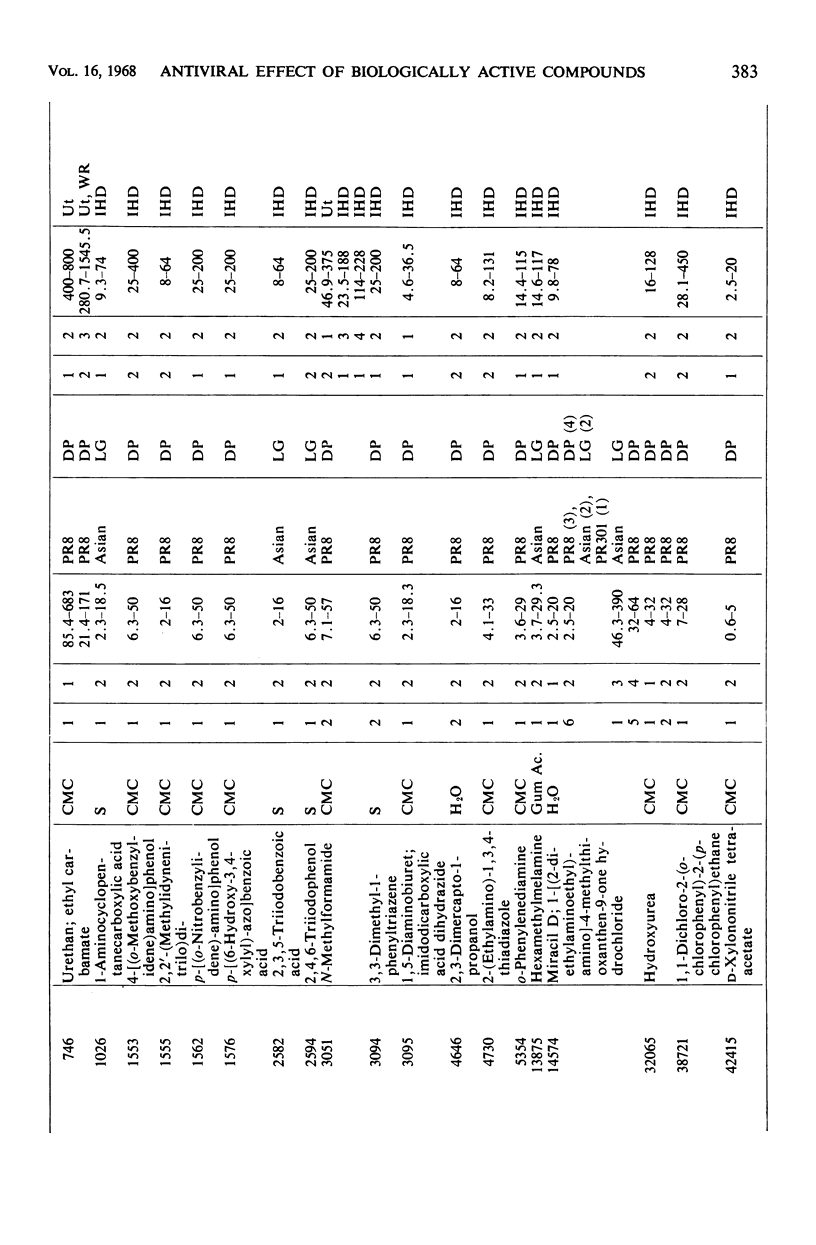
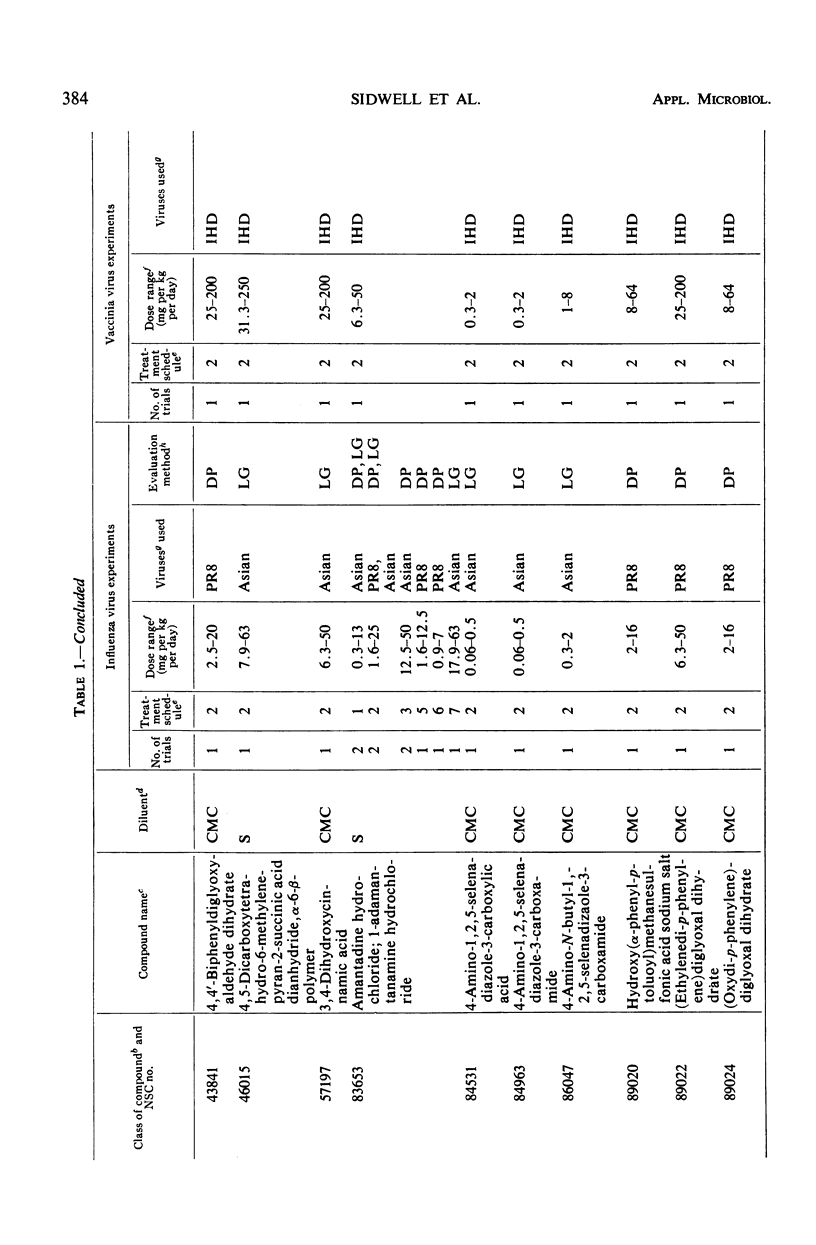
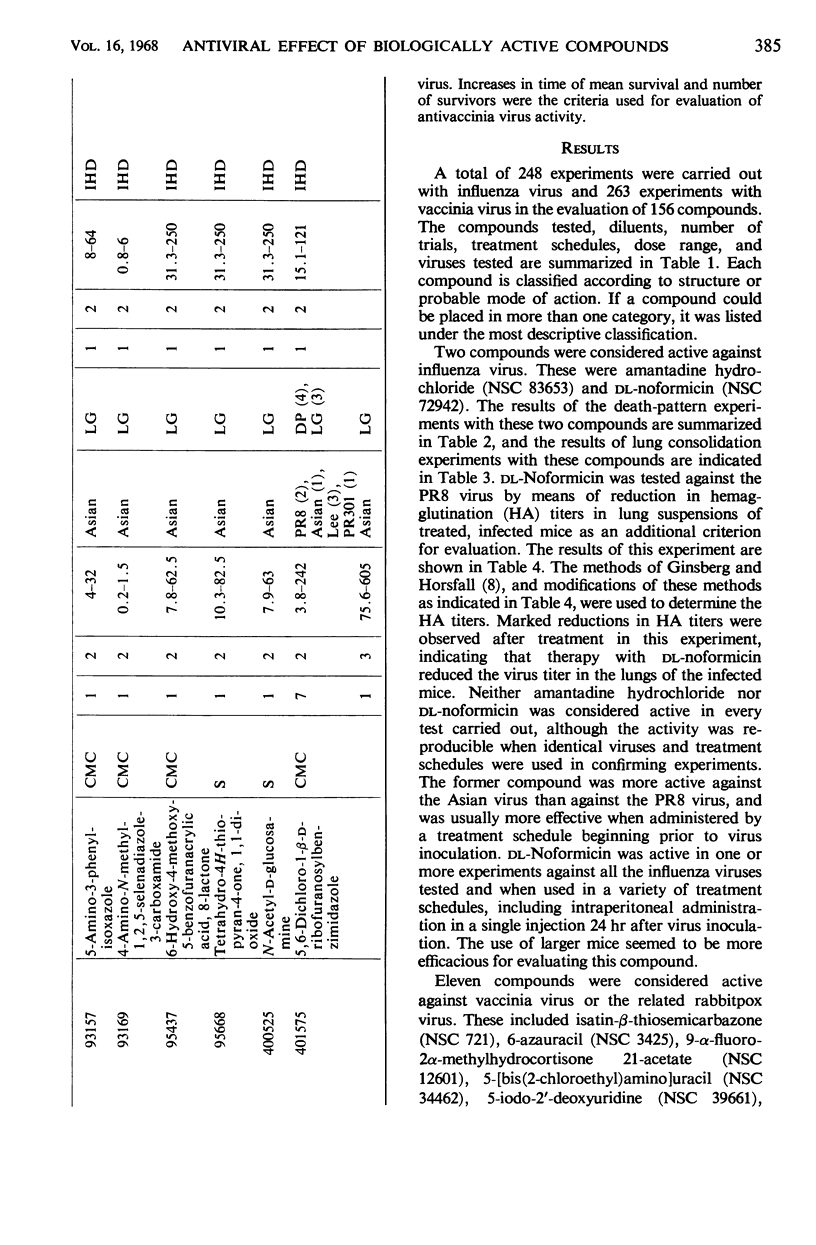
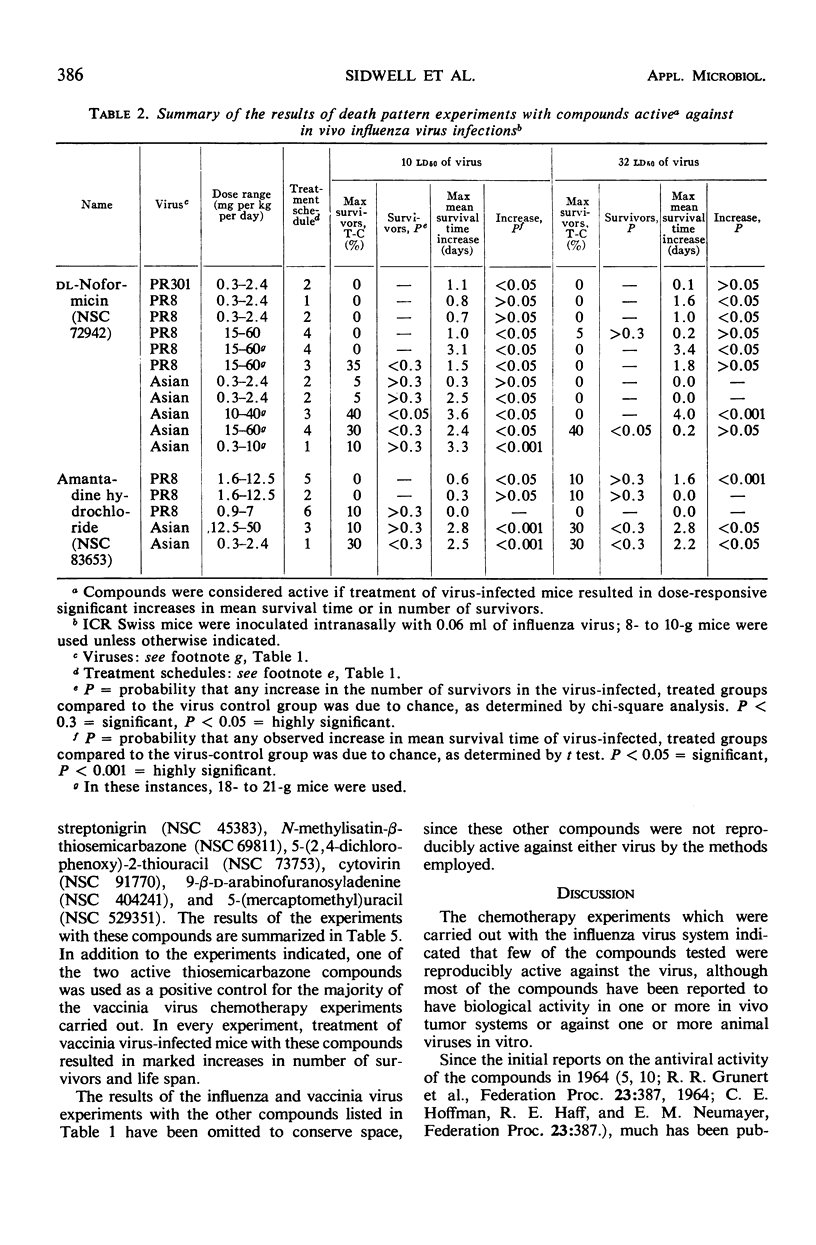
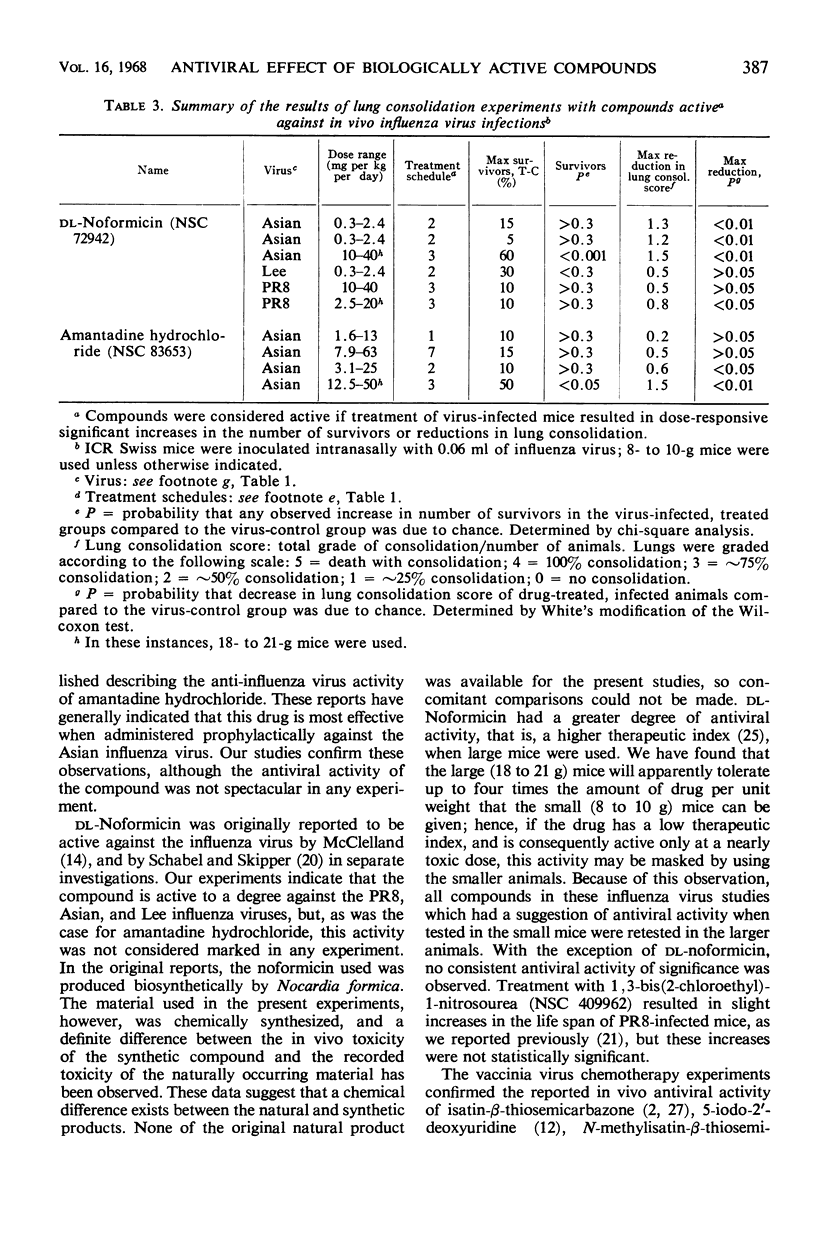
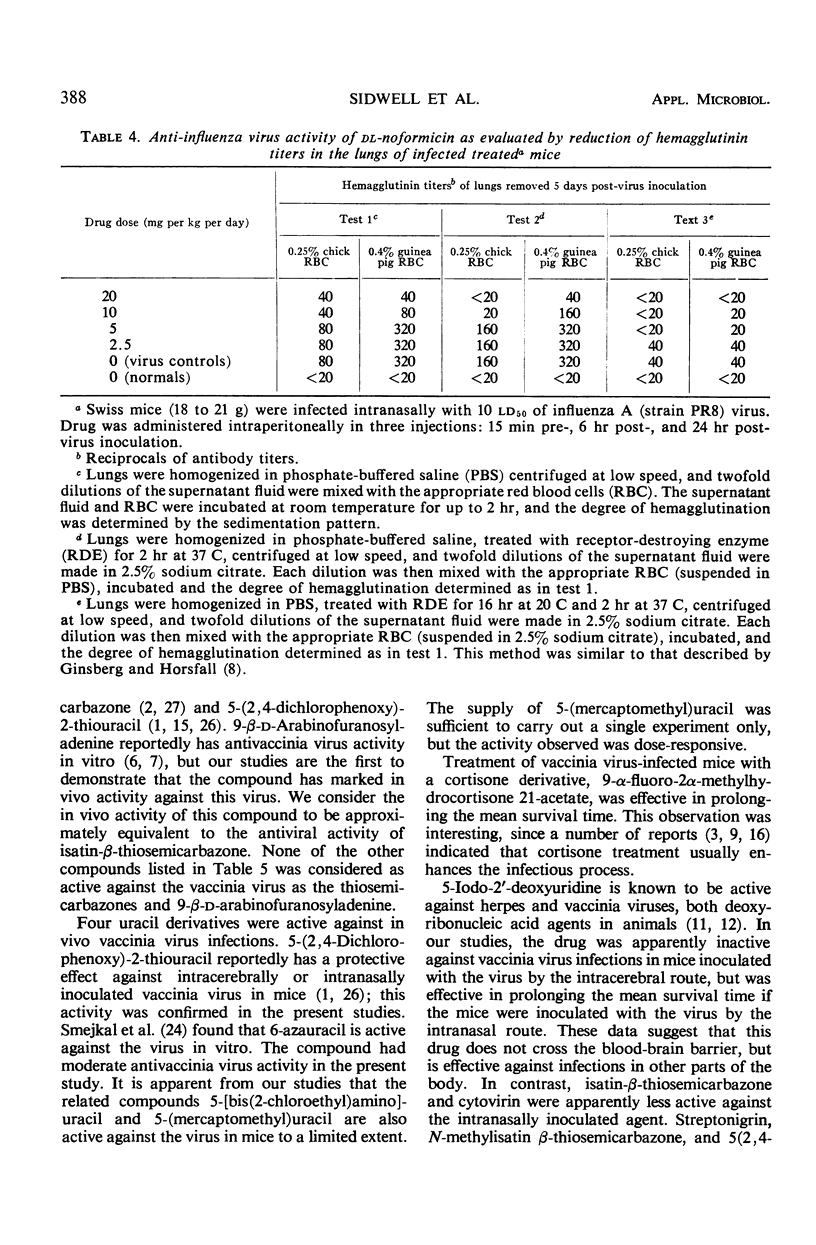
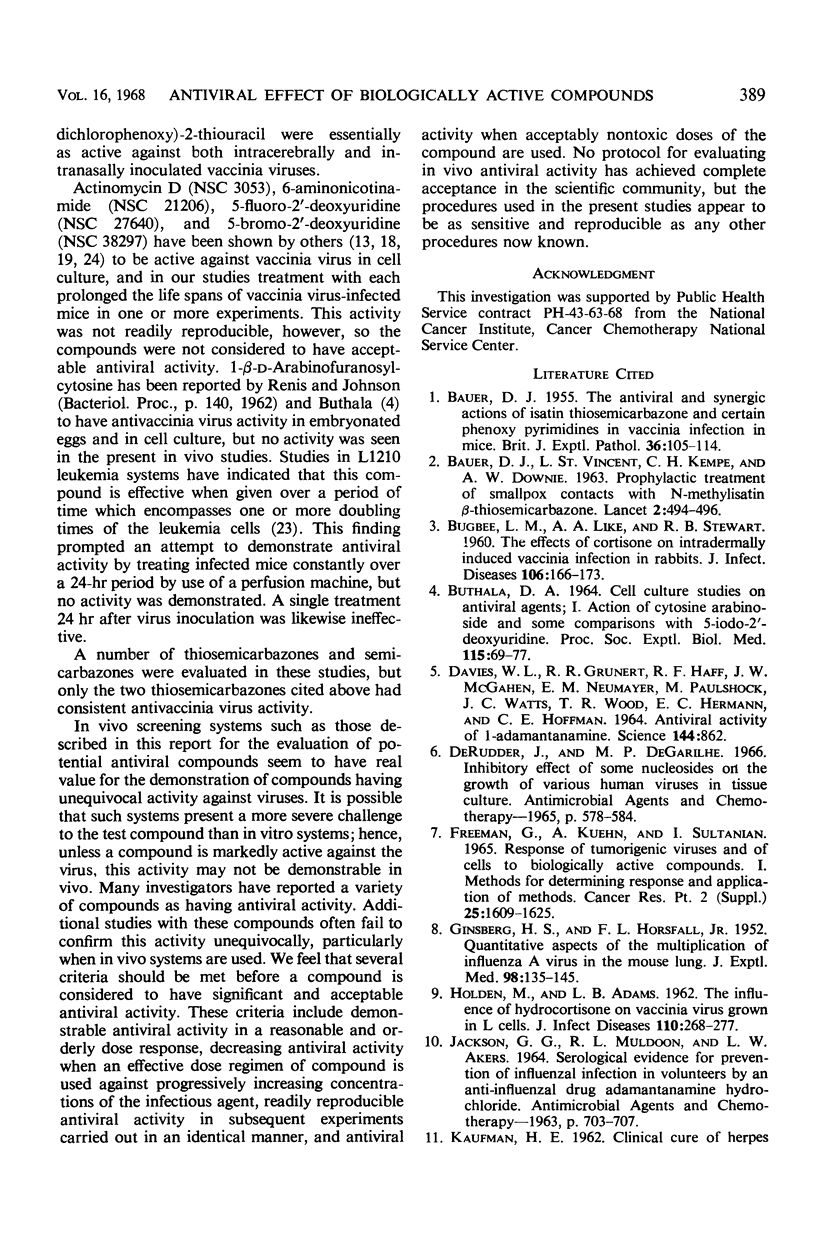
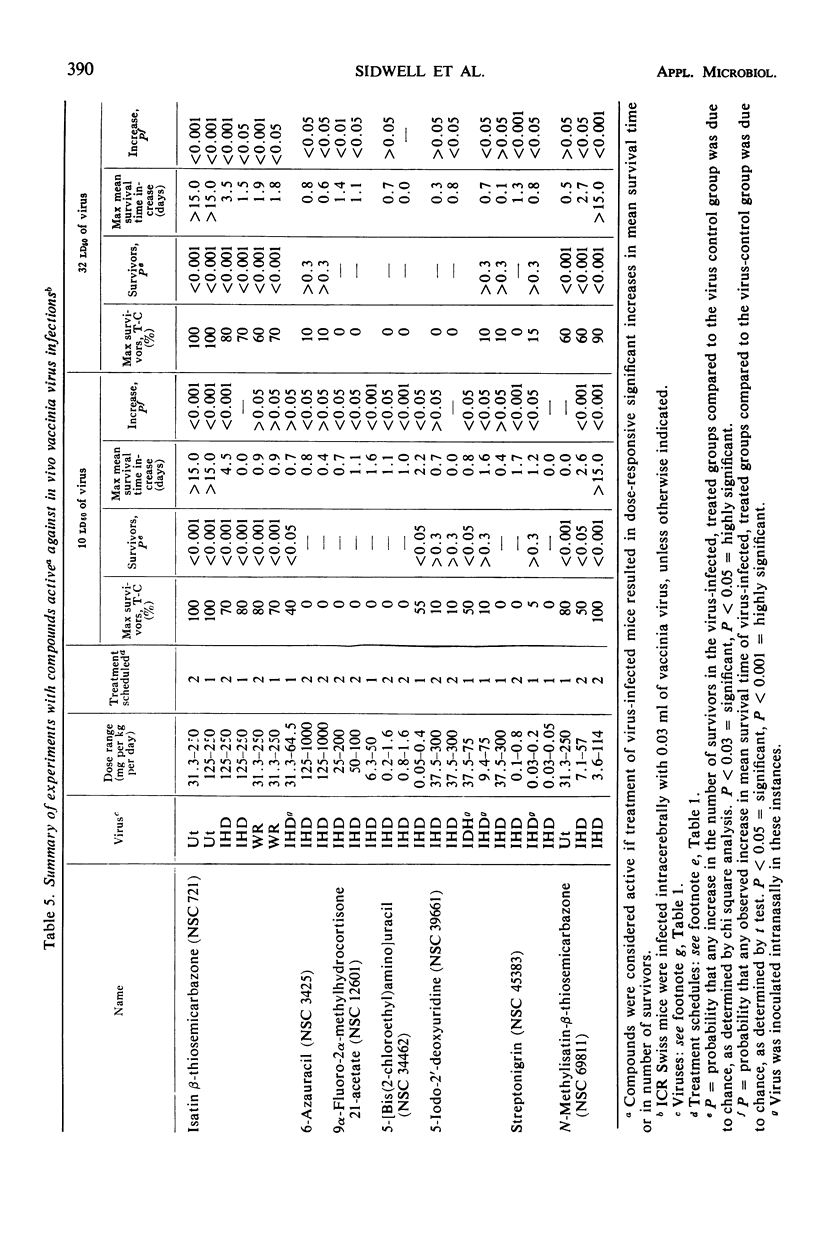
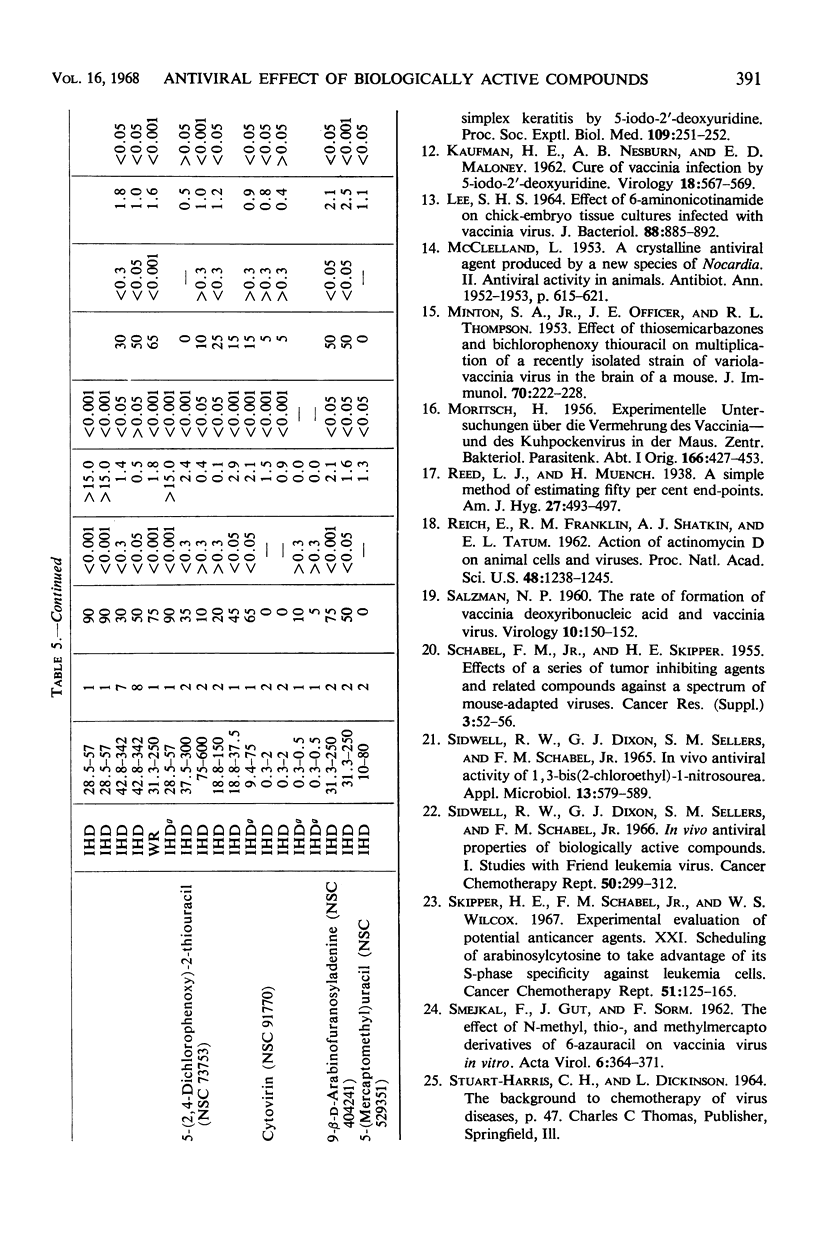
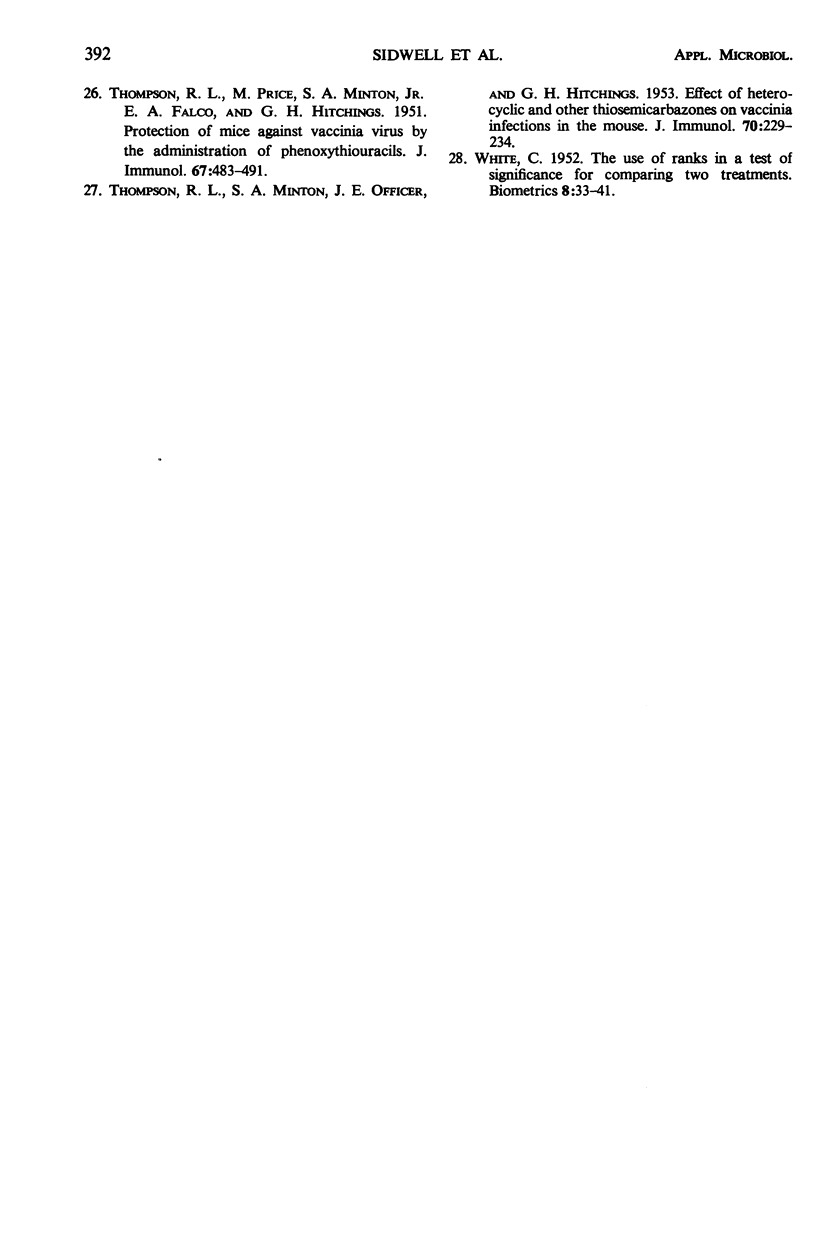
Selected References
These references are in PubMed. This may not be the complete list of references from this article.
- BAUER D. J., STVINCENT L., KEMPE C. H., DOWNIE A. W. PROPHYLACTIC TREATMENT OF SMALL POX CONTACTS WITH N-METHYLISATIN BETA-THIOSEMICARBAZONE (COMPOUND 33T57, MARBORAN). Lancet. 1963 Sep 7;2(7306):494–496. doi: 10.1016/s0140-6736(63)90230-7. [DOI] [PubMed] [Google Scholar]
- BAUER D. J. The antiviral and synergic actions of isatin thiosemicarbazone and certain phenoxypyrimidines in vaccinia infection in mice. Br J Exp Pathol. 1955 Feb;36(1):105–114. [PMC free article] [PubMed] [Google Scholar]
- BUGBEE L. M., LIKE A. A., STEWART R. B. The effects of cortisone on intradermally induced vaccinia infection in rabbits. J Infect Dis. 1960 Mar-Apr;106:166–173. doi: 10.1093/infdis/106.2.166. [DOI] [PubMed] [Google Scholar]
- BUTHALA D. A. CELL CULTURE STUDIES ON ANTIVIRAL AGENTS. I. ACTION OF CYTOSINE ARABINOSIDE AND SOME COMPARISONS WITH 5-IODO-2-DEOXYURIDINE. Proc Soc Exp Biol Med. 1964 Jan;115:69–77. doi: 10.3181/00379727-115-28834. [DOI] [PubMed] [Google Scholar]
- DAVIES W. L., GRUNERT R. R., HAFF R. F., MCGAHEN J. W., NEUMAYER E. M., PAULSHOCK M., WATTS J. C., WOOD T. R., HERMANN E. C., HOFFMANN C. E. ANTIVIRAL ACTIVITY OF 1-ADAMANTANAMINE (AMANTADINE). Science. 1964 May 15;144(3620):862–863. doi: 10.1126/science.144.3620.862. [DOI] [PubMed] [Google Scholar]
- Freeman G., Kuehn A., Sultanian I. Response of tumorigenic viruses and of cells to biologically active compounds. I. Methods for determining response and application of methods. Cancer Res. 1965 Oct;25(9 Pt 2):1609–1625. [PubMed] [Google Scholar]
- GINSBERG H. S., HORSFALL F. L., Jr Quantitative aspects of the multiplication of influenza A virus in the mouse lung; relation between the degree of viral multiplication and the extent of pneumonia. J Exp Med. 1952 Feb;95(2):135–145. doi: 10.1084/jem.95.2.135. [DOI] [PMC free article] [PubMed] [Google Scholar]
- HOLDEN M., ADAMS L. B. The influence of hydrocortisone on vaccinia virus grown in L cells. J Infect Dis. 1962 May-Jun;110:268–277. doi: 10.1093/infdis/110.3.268. [DOI] [PubMed] [Google Scholar]
- KAUFMAN H. E., NESBURN A. B., MALONEY E. D. Cure of vaccinia infection by 5-iodo-2'-deoxyuridine. Virology. 1962 Dec;18:567–569. doi: 10.1016/0042-6822(62)90058-2. [DOI] [PubMed] [Google Scholar]
- LEE S. H. EFFECT OF 6-AMINONICOTINAMIDE ON CHICK-EMBRYO TISSUE CULTURES INFECTED WITH VACCINIA VIRUS. J Bacteriol. 1964 Oct;88:885–892. doi: 10.1128/jb.88.4.885-892.1964. [DOI] [PMC free article] [PubMed] [Google Scholar]
- MINTON S. A., Jr, OFFICER J. E., THOMPSON R. L. Effect of thiosemicarbazones and dichlorophenoxy thiouracil on multiplication of a recently isolated strain of variola-vaccinia virus in the brain of the mouse. J Immunol. 1953 Mar;70(3):222–228. [PubMed] [Google Scholar]
- REICH E., FRANKLIN R. M., SHATKIN A. J., TATUMEL Action of actinomycin D on animal cells and viruses. Proc Natl Acad Sci U S A. 1962 Jul 15;48:1238–1245. doi: 10.1073/pnas.48.7.1238. [DOI] [PMC free article] [PubMed] [Google Scholar]
- SALZMAN N. P. The rate of formation of vaccinia deoxyribonucleic acid and vaccinia virus. Virology. 1960 Jan;10:150–152. doi: 10.1016/0042-6822(60)90015-5. [DOI] [PubMed] [Google Scholar]
- SCHABEL F. M., Jr, SKIPPER H. E. Effects of a series of tumor-inhibiting agents and related compounds against a spectrum of mouse-adapted viruses. Cancer Res. 1955;Suppl. 3:52–56. [PubMed] [Google Scholar]
- SIDWELL R. W., DIXON G. J., SELLERS S. M., SCHABEL F. M., Jr IN VIVO ANTIVIRAL ACTIVITY OF 1,3-BIS(2-CHLOROETHYL)-1-NITROSOUREA. Appl Microbiol. 1965 Jul;13:579–589. doi: 10.1128/am.13.4.579-589.1965. [DOI] [PMC free article] [PubMed] [Google Scholar]
- SMEJKAL F., GUT J., SORM F. The effect of N-methyl-thio-, and methylmercaptoderivatives of 6-azauracil on vaccinia virus in vitro. Acta Virol. 1962 Jul;6:364–371. [PubMed] [Google Scholar]
- Skipper H. E., Schabel F. M., Jr, Wilcox W. S. Experimental evaluation of potential anticancer agents. XXI. Scheduling of arabinosylcytosine to take advantage of its S-phase specificity against leukemia cells. Cancer Chemother Rep. 1967 Jun;51(3):125–165. [PubMed] [Google Scholar]
- THOMPSON R. L., MINTON S. A., Jr, OFFICER J. E., HITCHINGS G. H. Effect of heterocyclic and other thiosemicarbazones on vaccinia infection in the mouse. J Immunol. 1953 Mar;70(3):229–234. [PubMed] [Google Scholar]
- THOMPSON R. L., PRICE M., MINTON S. A., Jr, FALCO E. A., HITCHINGS G. H. Protection of mice against the vaccinia virus by the administration of phenoxythiouracils. J Immunol. 1951 Dec;67(6):483–491. [PubMed] [Google Scholar]


